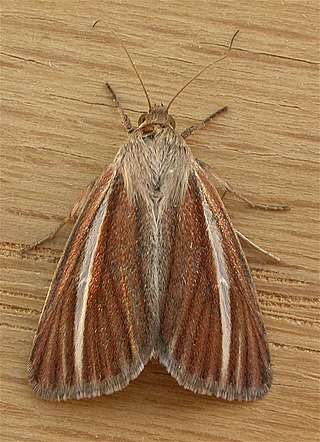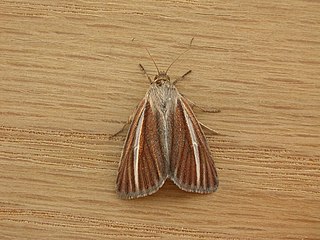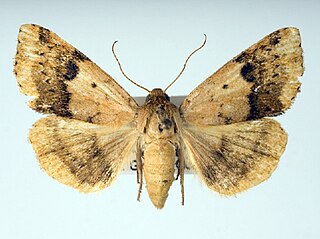
The Noctuidae, commonly known as owlet moths, cutworms or armyworms, are a family of moths. They are considered the most controversial family in the superfamily Noctuoidea because many of the clades are constantly changing, along with the other families of the Noctuoidea. It was considered the largest family in Lepidoptera for a long time, but after regrouping Lymantriinae, Catocalinae and Calpinae within the family Erebidae, the latter holds this title now. Currently, Noctuidae is the second largest family in Noctuoidea, with about 1,089 genera and 11,772 species. This classification is still contingent, as more changes continue to appear between Noctuidae and Erebidae.

Pearl millet is the most widely grown type of millet. It has been grown in Africa and the Indian subcontinent since prehistoric times. The center of diversity, and suggested area of domestication, for the crop is in the Sahel zone of West Africa. Recent archaeobotanical research has confirmed the presence of domesticated pearl millet on the Sahel zone of northern Mali between 2500 and 2000 BC. 2023 was the International Year of Millets, declared by the United Nations General Assembly in 2021.

Heliocheilus cramboides is a moth of the family Noctuidae. It is found in Victoria, Western Australia, the Australian Capital Territory, New South Wales, the Northern Territory, Queensland and South Australia.
Surattha is a genus of moths of the family Crambidae. The genus was synonymized with Prionapteryx by Stanisław Błeszyński in 1967. Its status was later revised by Graziano Bassi and Wolfram Mey in 2011.

Heliocheilus is a genus of moths of the family Noctuidae. Former synonyms include Canthylidia.

Heliocheilus cistella is a moth in the family Noctuidae. It is found in the Australian states of Northern Territories, Queensland and Western Australia.

Heliocheilus mesoleuca is a moth in the family Noctuidae first described by Oswald Bertram Lower in 1902. It is found in Australia in New South Wales, the Northern Territory, Queensland and South Australia.

Heliocheilus julia is a North American moth in the family Noctuidae. Heliocheilus julia is attracted to lights. Its life history and host plants are unknown.

Heliocheilus confertissima is a species of moth of the family Noctuidae. It is found from Northern Africa to the Middle East, including Saudi Arabia, Iran and Oman.

Heliocheilus paradoxus, the paradoxical grass moth, is a species of moth of the family Noctuidae. It is found from Ontario and British Columbia, south to at least California, Arizona, Texas and Florida.
Heliocheilus albivenata is a moth in the family Noctuidae. It is endemic to Western Australia.

Heliocheilus turbata, the spotted straw moth, is a moth in the family Noctuidae. It is found in North America, including Georgia.

Heliocheilus lupatus, the purple topper, lupatus straw moth or spotted straw moth, is a moth in the family Noctuidae. The species was first described by Augustus Radcliffe Grote in 1875. It is found in the United States from Kentucky and central Connecticut south to Florida and Texas.
Sochchora albipunctella is a moth of the family Pterophoridae. It is known from Brazil.
Heliocheilus thomalae is a moth in the family Noctuidae. It is found in Tanzania.

Depressaria albipunctella is a moth of the family Depressariidae. It is found in most of Europe, as well as in Libya.
Nudaria albipunctella is a moth of the family Erebidae first described by George Hampson in 1914. It is found on Borneo, Sumatra and Peninsular Malaysia.

Ebenezer Oduro Owusu is a Ghanaian entomologist and university administrator who served as the Vice Chancellor of the University of Ghana from 1 August 2016 to 31 July 2021. In this role, he was the principal academic and administrative officer of the university. Owusu is a professor of entomology at the Department of Animal Biology and Conservation Science and prior to his appointment as vice-chancellor, he was the provost of the College of Basic and Applied Sciences at the University of Ghana. He is the current President of the Presbyterian University College.









